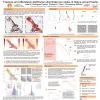Poster #129, Fault and Rupture Mechanics (FARM)
Small Magnitude Seismicity Helps Identify Transient Signals of Fault Creep on the North Anatolian Fault in Noisy GPS Recordings
Poster Image:

Poster Presentation
2020 SCEC Annual Meeting, Poster #129, SCEC Contribution #10321 VIEW PDF
ismic activity in the rupture area of the 1999 Izmit earthquake (Izmit-Sapanca lake segment to Karadere segment) from 2008 to 2020. This earthquake catalog is then used to extract the signal associated with high seismic activity from the noisy GPS recordings. By leveraging continuous GPS data with one day resolution, this approach achieves better temporal resolution than previous studies based on InSAR, and thus allows us to reveal the non-stationary nature of aseismic slip in this region. Our results show that periods of high seismic activity are systematically accompanied by strong deviations from the long-term motion in the GPS time series, with eastward or southeastward motion of the GPS stations located in the northern block of the NAF. These deviations are evidence for the existence of transient aseismic slip episodes (deep slow slip or shallow creep). We identify groups of earthquakes, taking place on different faults, that are associated with different styles of motion. Thus, our study sheds new light on the temporal and spatial complexity of aseismic slip on the North Anatolian Fault.
SHOW MORE
SHOW MORE























































